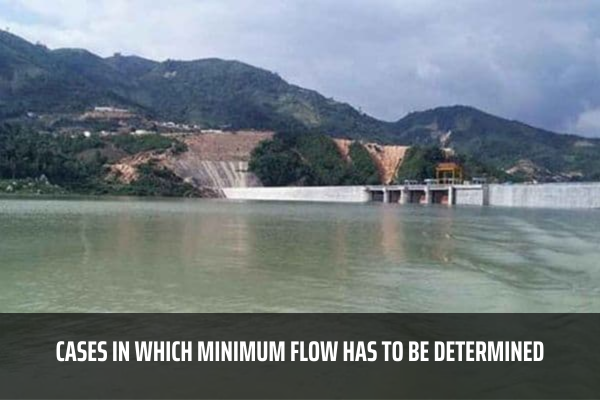What are the cases in which minimum flow has to be determined in Vietnam under the Law on Water Resources 2023?
What are the cases in which minimum flow has to be determined in Vietnam under the Law on Water Resources 2023?
Pursuant to the provisions of Clause 18, Article 2 of the Law on Water Resources 2023, “minimum flow” means a flow at the lowest level necessary for maintaining a river or river section in order to assure the normal development of aquatic ecosystems and maintain a minimum level for the exploitation and use of water.
Pursuant to Clause 1, Article 24 of the Law on Water Resources 2023, cases in which minimum flow has to be determined are as follows:
- Rivers and streams in which water transfer structures, large dams, reservoirs and water exploitation structures exist, potentially affecting people's livelihoods, socio - economic development, and aquatic ecosystems.
According to local resources and conditions for socio - economic development, importance of water sources, requirements for natural disaster management and requirements for water source protection, the competent authority specified in clauses 6 and 7 of Article 24 of the Law on Water Resources 2023 shall decide the order of priority, locations where minimum flow needs to be maintained on each river or stream for which minimum flow needs to be determined.
- Dams and reservoirs built in rivers and streams, except for the dams and reservoirs which have been put into operation, making it unable to adjust or add any minimum flow discharge structure item.

What are the cases in which minimum flow has to be determined in Vietnam under the Law on Water Resources 2023? (Picture from internet)
What are the bases for determining minimum flow in Vietnam under the Law on Water Resources 2023?
Pursuant to Clause 4, Article 24 of the Law on Water Resources 2023, bases for determining minimum flow are composed of:
- Hydrological characteristics, flow regime and functions of water sources; status and demands for exploitation and use of water resources;
- Requirements for protection and prevention of deterioration, depletion and pollution of water sources; protection and conservation of aquatic ecosystems and biodiversity; natural disaster management; assurance about national defense, security and other requirements related to water source protection;
- Scale, scope of impact, exploitation method and ability to regulate water for dams and reservoirs;
- International agreements and treaties related to water resources with countries sharing water sources to which the Socialist Republic of Vietnam is a signatory.
Pursuant to Clause 3, Article 4 of Circular 64/2017/TT-BTNMT, the comprehensive consideration of the following factors is required during the process of determining the minimum flow in order to select the specific value of the minimum flow at each location appropriately:
- Hydrological characteristics, flow regime, flow distribution in rivers and streams, water contribution ratio of rivers and streams in the river system, and functions of the water source.
- Current conditions and water exploitation and use needs of direct water users on rivers and streams.
- Requirements for protection and prevention of water depletion and degradation, meeting minimum water use needs in cases of drought, severe water shortage, requirements for protection and conservation of aquatic ecosystems, biodiversity, national defense, security, and other water protection-related requirements.
- Scale, scope of impact, exploitation methods, arrangement of construction works, and water regulation capacity for reservoirs.
- Provisions of international conventions of which the Socialist Republic of Vietnam is a member, in cases related to transboundary water resources.
Where are the locations for determining minimum flow in Vietnam?
Pursuant to Article 6 of Circular 64/2017/TT-BTNMT, the minimum flow is determined for specific locations on rivers, streams, or downstream reservoirs and is implemented as follows:
(1) For rivers and streams:
- The location to determine the minimum flow on rivers and streams is the river or stream mouth before it enters the receiving water body. In cases where there is a hydrological station on the river or stream, and the station's location represents the flow regime of the river or stream, the hydrological station is chosen as the location to determine the minimum flow.
- In addition to the specified location, if there are specific requirements to ensure activities such as water exploitation, cultural, sports, and tourism activities, or requirements for the protection of aquatic ecosystems, biodiversity conservation, economically valuable aquatic species on one or more river or stream sections, the competent state agency specified in Article 9 of Circular 64/2017/TT-BTNMT shall consider and decide to supplement additional locations to determine the minimum flow.
(2) For reservoirs:
- The location to determine the minimum flow downstream of the reservoir is immediately after the dam. In cases where there is a hydrological station controlling the flow regime of the reservoir downstream, the hydrological station is chosen as the location to determine the minimum flow. The minimum flow at this location includes the regularly and continuously maintained minimum flow and the minimum flow appropriate for the water regime and duration of water use downstream.
- For reservoirs that interrupt the flow of rivers or streams, in addition to the specified location for determining the minimum flow, it is also necessary to determine the minimum flow immediately after the section where the flow is returned to the river or stream or immediately after the hydropower plant. The minimum flow at this location is maintained in accordance with the water regime and duration of water use downstream.
The Law on Water Resources 2023 comes into force from July 1, 2024 except for Clauses 3 and 4, Article 85 of the Law on Water Resources 2023.
LawNet

